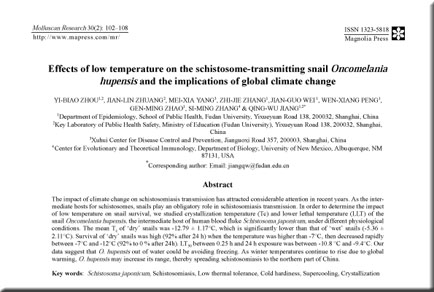Abstract
The impact of climate change on schistosomiasis transmission has attracted considerable attention in recent years. As the inter-mediate hosts for schistosomes, snails play an obligatory role in schistosomiasis transmission. In order to determine the impact of low temperature on snail survival, we studied crystallization temperature (Tc) and lower lethal temperature (LLT) of the snail Oncomelania hupensis, the intermediate host of human blood fluke Schistosoma japonicum, under different physiological conditions. The mean Tc of ‘dry’ snails was -12.79 ± 1.17°C, which is significantly lower than that of ‘wet’ snails (-5.36 ± 2.11°C). Survival of ‘dry’ snails was high (92% after 24 h) when the temperature was higher than -7°C, then decreased rapidly between -7°C and -12°C (92% to 0 % after 24h). LT50 between 0.25 h and 24 h exposure was between -10.8 °C and -9.4°C. Our data suggest that O. hupensis out of water could be avoiding freezing. As winter temperatures continue to rise due to global warming, O. hupensis may increase its range, thereby spreading schistosomiasis to the northern part of China.

